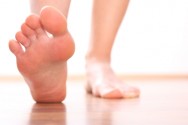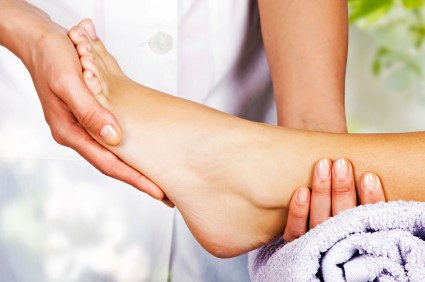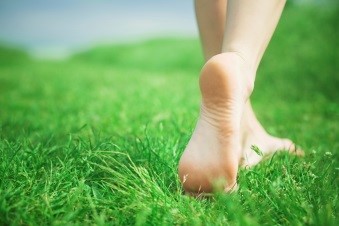Blog
The Best Ways to Avoid Heel Spurs
 Heel spurs occur when there is extreme strain on the heel bone and surrounding ligaments causing a calcium deposit on the heel bone. In order to avoid the painful condition many suggest to wear shoes that are your size, massage the feet after walking around in heels and consider switching to a flatter shoe, and stretch the feet. Additionally, running on hard surfaces or barefoot can increase risk of heel spurs. Avoid exerting too much pressure on the heels and get fitted for a proper running shoe to reduce chances of heel spurs forming.
Heel spurs occur when there is extreme strain on the heel bone and surrounding ligaments causing a calcium deposit on the heel bone. In order to avoid the painful condition many suggest to wear shoes that are your size, massage the feet after walking around in heels and consider switching to a flatter shoe, and stretch the feet. Additionally, running on hard surfaces or barefoot can increase risk of heel spurs. Avoid exerting too much pressure on the heels and get fitted for a proper running shoe to reduce chances of heel spurs forming.
Heel spurs can be incredibly painful, and sometimes might make you unable to participate in physical activities. To get medical care for your heel spurs, call one of our podiatrists of Pennsylvania. Our doctors will do everything possible to treat your condition.
Heels Spurs
Heel spurs are formed by calcium deposits on the back of the foot where the heel is. This can also be a cause from small fragments of bone breaking off one section of the foot, attaching it to the back of the foot. Heel spurs can also be bone growth on the back of the foot. Bone may grow in the direction of the arch of the foot.
Older individuals usually suffer from heel spurs. Pain sometimes intensifies with age. Heel spurs are known to cause a substantial amount of pain. One of the main associations spurs are related to is plantar fasciitis.
Pain
The pain associated with spurs is often times because of weight placed on the feet. When someone is walking their entire weight is concentrated on the feet. Bone spurs then have the tendency to poke and affect other boners and tissues around the foot. As the pain continues the feet will become tender and sensitive over time.
Treatments
There are many ways to treat heel spurs. If one is suffering from heel spurs in conjunction with pain there are several methods for healing. Medicines, surgery, and herbal care are some options.
For more information about Heel Spurs, follow the link below.
If you have any questions feel free to contact our offices in Plymouth Meeting and Ambler, PA. We offer the latest in diagnostic and treatment technology to meet your needs.
Woman Runs Marathon with Morton’s Nueroma In Memory of Deceased Best Friend
 Breast Cancer Now leader Lynn Parfey participated in her first ever run at the recent Great North Run as a commitment to the dying words of her friend Shirley Garman, despite suffering from Morton’s Neuroma. Although Parfey dealt with the excruciating pain in her feet to take on the 13.1 mile challenge, doing it in her friend's memory was worth it. “I’m not brave,” shared Parfey. “The people that go through any form of cancer are the brave ones…. I’m not getting any younger and I just want to do something different to do what I can.” Parfey first involved herself with the charity in 2008.
Breast Cancer Now leader Lynn Parfey participated in her first ever run at the recent Great North Run as a commitment to the dying words of her friend Shirley Garman, despite suffering from Morton’s Neuroma. Although Parfey dealt with the excruciating pain in her feet to take on the 13.1 mile challenge, doing it in her friend's memory was worth it. “I’m not brave,” shared Parfey. “The people that go through any form of cancer are the brave ones…. I’m not getting any younger and I just want to do something different to do what I can.” Parfey first involved herself with the charity in 2008.
Morton’s Neuroma is a very uncomfortable condition to live with. If you think you have Morton’s neuroma contact Dr. Michael E. Newman and Dr. Denise Kohler of Pennsylvania. Our doctors will treat your foot and ankle needs.
Morton’s Neuroma
Morton's neuroma is a painful foot condition that commonly affects the areas between the second and third or third and fourth toe, although other areas of the foot are also susceptible. Morton’s neuroma is caused by an inflamed nerve in the foot that is being squeezed and aggravated by surrounding bones.
What Increases the Chances of having Morton’s Neuroma?
- -Ill-fitting high heels or shoes that add pressure to the toe or foot
- -Jogging, running or any sport that involves constant impact to the foot
- -Flat feet, bunions, and any other foot deformities
Morton’s neuroma is a very treatable condition. Orthotics and shoe inserts can often be used to alleviate the pain on the forefront of the feet. In more severe cases, corticosteroids can also be prescribed. In order to figure out the best treatment for your neuroma, it’s recommended to seek the care of a podiatrist who can diagnose your condition and provide different treatment options.
If you have any questions please feel free to contact our offices located in Plymouth Meeting and Ambler, PA. We offer the newest diagnostic tools and treatments to treat your foot and ankle needs.
Standing Desks May be Better for Overall Health
 Lisa Raphael leader of the editorial team at Brit & Co. has been using her standing desk for quite some time and has found the benefits work for foot health, body health, and fashion. While initially taking on the standing desk after reading a Harvard Business Review article where sitting for more than six hours a day can increase death by 37%, Raphael began to notice that her clothes were less wrinkled and she had more options for skirt wear since it was easier to stand in a skirt than to sit. The editor also recognized that high heels would not be an option while standing up for most of the day for the sake of achy feet. “A lot of women will kick off the heels and stand barefoot, which is good for the body,” stated Colin Ferry, vice president of Ergo Depot, manufacturer of standing desks.
Lisa Raphael leader of the editorial team at Brit & Co. has been using her standing desk for quite some time and has found the benefits work for foot health, body health, and fashion. While initially taking on the standing desk after reading a Harvard Business Review article where sitting for more than six hours a day can increase death by 37%, Raphael began to notice that her clothes were less wrinkled and she had more options for skirt wear since it was easier to stand in a skirt than to sit. The editor also recognized that high heels would not be an option while standing up for most of the day for the sake of achy feet. “A lot of women will kick off the heels and stand barefoot, which is good for the body,” stated Colin Ferry, vice president of Ergo Depot, manufacturer of standing desks.
While working on the feet, it is important to take the proper care of them. For more information about working on your feet, contact Dr. Michael E. Newman of Pennsylvania. Our doctor will treat your foot and ankle needs.
Working on Your Feet
Standing on your feet for long periods of time can cause stress and pain in your feet. Your whole body may experience change in terms of posture, back pain, bunions, callouses and or plantar warts. There are ways to avoid these conditions with proper foot care, smart choices and correct posture.
Positive Changes
Negative heeled shoe – choosing this shoe places the heel slightly lower than the ball of the foot. These are great for overall foot health. Find shoes that fit you correctly.
Go barefoot – our feet were not designed to be enclosed for hours, or all day. Try allowing yourself to expose your feet to air.
Eliminate Pain
Foot Exercises – performing simple exercises, incorporating yoga and stretches is beneficial. This will allow increased blood flow to the area and muscles of the foot.
Achilles tendon – stretching the foot out flat on the floor, will relax the calf muscles and tendon. These exercises can be performed almost anywhere. Make sure you add these exercises to your daily regimen.
With a little bit of this information and knowing more about foot health, you will notice changes. Foot stretches and proper footwear will help with pain and prevent further issues.
Keep your feet healthy and your body will thank you for it.
If you have any questions please feel free to contact our office located in Plymouth Meeting and Ambler, PA. We offer the newest diagnostic and treatment technologies for all your foot and ankle needs.
Having the Proper Items in your Gym Bag may Help Prevent Athlete’s Foot
 According to Amanda Lauren from CheatSheet, there are a few vital objects to keep in your gym bag to avoid infections such as athlete’s foot. For starters keeping a pair of flip-flops with you for those post-workout showers is extremely important since public showers are often breeding grounds for athlete’s foot. Keeping the feet dry is also important in avoiding foot problems; keeping moisture wicking socks in your gym bag are great for changing post workout for hygienic reasons and to keep your feet dry.
According to Amanda Lauren from CheatSheet, there are a few vital objects to keep in your gym bag to avoid infections such as athlete’s foot. For starters keeping a pair of flip-flops with you for those post-workout showers is extremely important since public showers are often breeding grounds for athlete’s foot. Keeping the feet dry is also important in avoiding foot problems; keeping moisture wicking socks in your gym bag are great for changing post workout for hygienic reasons and to keep your feet dry.
Athlete’s foot is an inconvenient condition that can be easily reduced with the proper treatment. If you are concerned about your athlete’s foot, contact our podiatrists Dr. Michael E. Newman and Dr. Denise Kohler of Pennsylvania. Our doctors will treat your foot and ankle needs.
Athlete’s Foot: The Sole Story
Athlete's foot, also known as tinea pedis, can be an extremely contagious foot infection. It is commonly contracted in public changing areas and bathrooms, dormitory style living quarters, around locker rooms and public swimming pools, or anywhere your feet often come into contact with other people.
Solutions to Combat Athlete’s Foot
- Hydrate your feet by using lotion
- Exfoliate
- Buff off nails
- Use of anti-fungal products
- Examine your feet and visit your doctor if any suspicious blisters or cuts develop
Athlete’s foot can cause many irritating symptoms such as dry and flaking skin, itching, and redness. Some more severe symptoms can include bleeding and cracked skin, intense itching and burning and even pain when walking. In the worst cases, athlete’s foot can cause blistering as well. Speaking to your podiatrist will give you a better understanding of the different causes of athlete’s foot, as well as helping you figure out which treatment options are best for you.
If you have any questions please feel free to contact our offices located in Plymouth Meeting and Ambler, PA. We offer the newest diagnostic tools and technology to treat your foot and ankle needs.
